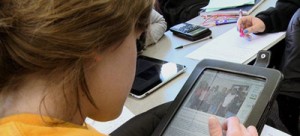In 2010-11, CEHD Dean Jean Quam and David Ernst, CEHD’s chief information officer, speculated about the use of the newly released iPad tablet with CEHD’s 450 new freshmen:
• Could it improve teaching and learning?
• Could it reduce costs for students by leveraging digital content?
• What other benefits might there be?
 To answer these questions, CEHD administrative staff worked with faculty to help them integrate the iPads into their teaching and took a thorough look at course content to determine where costs could be reduced. After issuing iPads to incoming freshmen for the last four years, CEHD learned that iPad use by students and faculty has led to the following innovations:
To answer these questions, CEHD administrative staff worked with faculty to help them integrate the iPads into their teaching and took a thorough look at course content to determine where costs could be reduced. After issuing iPads to incoming freshmen for the last four years, CEHD learned that iPad use by students and faculty has led to the following innovations:
1. Use of Open Textbooks – Free, open-source, peer-reviewed, high quality textbooks were made available by the creation of the Open Textbook Catalog. In 2012-13, ten CEHD faculty chose to adopt open textbooks, saving their students approximately $100,000. In addition, the open license has allowed faculty to customize the textbooks to better meet their students’ needs. The initiative has caught the attention of the William and Flora Hewlett Foundation, which is considering providing funding to replicate this project nationally.
2. Digital Course Packs – CEHD partnered with the University Libraries, the Copyright Center, and the University Bookstore to create digital course packs of articles required by faculty for their courses. The new process ensures that students don’t need to purchase articles that are already licensed by the Libraries. In addition, students save money because the course packs are digital. (Students report that they prefer reading course materials on their iPads to printed versions by more than 2:1.) Students will only be charged if an article is not already licensed by the Library. In the 2012-13 pilot, nine CEHD faculty saved students over $14,000 by using digital course packs. This process is being spread University-wide including integration into the University’s course management system, Moodle, giving students a single point to access their course materials.
3. Use of Apple TV – CEHD pioneered the University’s use of Apple TVs to wirelessly project iPads from anywhere (or anyone) in the classroom. With help from the Office of Information Technology and Office of Classroom Management, this innovation has scaled to an enterprise service and is now available in most University classrooms. Apple TVs are easier to use and less expensive than smart boards, which are commonly used in K-12 classrooms.
4. Mobile Application – VideoANT is a powerful online tool that was developed by CEHD staff to allow faculty and students to give time-specific feedback on video recordings of performances. VideoANT can now be used on iPads in the field, as it is now mobile-enabled.
5. Treks Mobile – CEHD staff have extended the popular Treks faculty development program to include a Treks Mobile offering to help faculty use mobile devices in their teaching.
In addition, students have reported that the iPads positively impacted their academics by helping them:
• Complete course-related work outside the classroom (86%)
• Demonstrate their learning in more ways (85%)
• Communicate their ideas more effectively (76%)
• Feel more engaged in their courses (62%)
Read more about CEHD’s mobile teaching and learning initiatives. Also see the Star Tribune story “On campus beat: How iPad study cut text costs at U.”



